Wasps tend to have a bad reputation throughout the world. But even though they are sometimes aggressive, they are important to our ecosystem.
There are more than eighteen thousand wasp species in North America. There are only around thirty in North Carolina with the most common being yellow jackets, mud daubers, and hornets.
The 27 most common wasps in North Carolina from the most popular to the least popular include:
Table of Contents
1. Metric Paper Wasp
The metric paper wasp (Polistes metricus) is native to North America. They share nests with other wasps of the same species, sometimes reusing nests over multiple seasons.
They are a dark rusty color with black on their thorax with a black abdomen.
The female has six abdominal segments, while the males have seven.
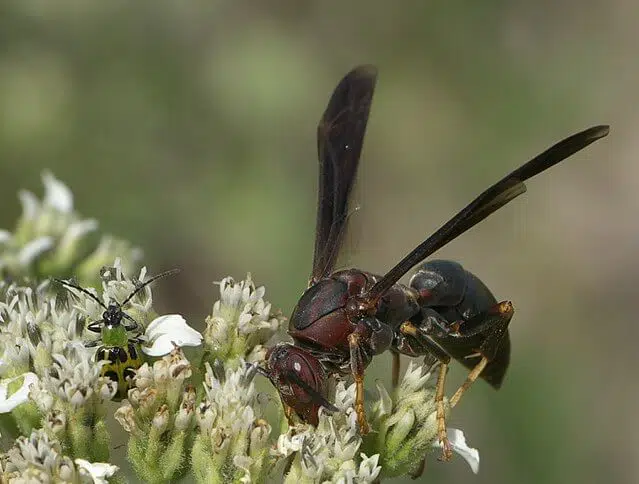
Females are yellow in limited areas with red and black. Males, on the other hand, have less coloration with more black. Males have more yellow on the face and legs.
These wasps are particular when choosing a nesting site, taking the elements, lighting, water, and size into consideration. They often build their nests in barns, sheds, and under eaves.
2. European Hornet
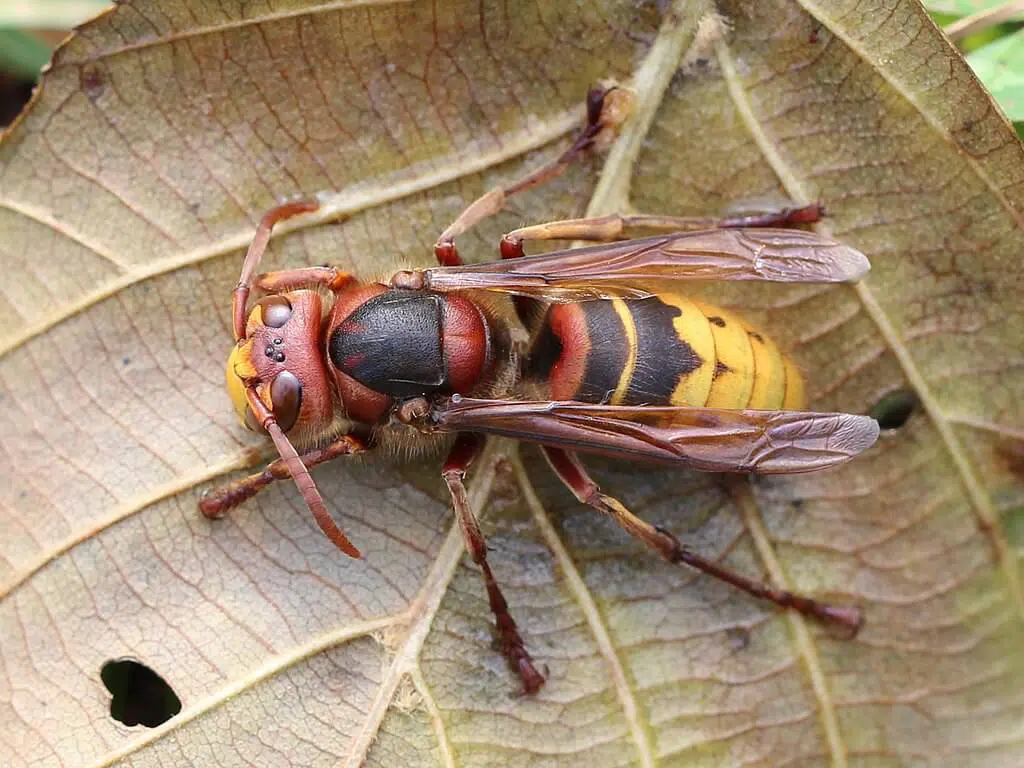
European hornets (Vespa crabro) are the only true hornet that can be found in North America. They were introduced in the 1800s by the European settlers. They will sting if grabbed or stepped on but tend to avoid conflict.
These hornets are carnivorous and hunt insects, including dragonflies, beetles, and other wasps. They are also known to eat fruit. They live in paper nests with a single entry hole made from twigs and plant resources which are chewed and shaped by the workers.
3. Eastern Yellowjacket
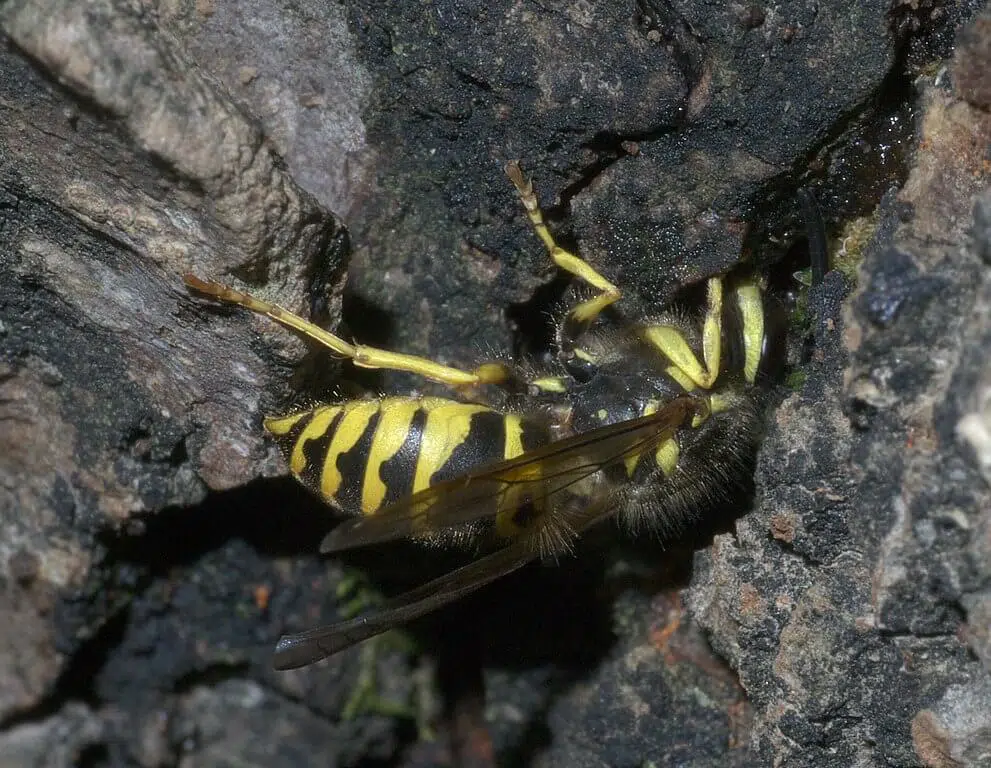
Eastern yellowjackets (Vespula maculifrons) are found in nests in buildings and recreational areas. They are social insects, living in colonies, sometimes hundreds of thousands of wasps. They will aggressively defend their nests from threats.
This wasp can give a very painful sting, even though they are smaller in size than other wasp species. They have yellow lines on their abdomen, head, and thorax with a curved body shape.
They build their nests above the ground, taking a liking to buildings in subterranean areas. Their nests can also be found in forests and on creek banks.
4. Dark Paper Wasp
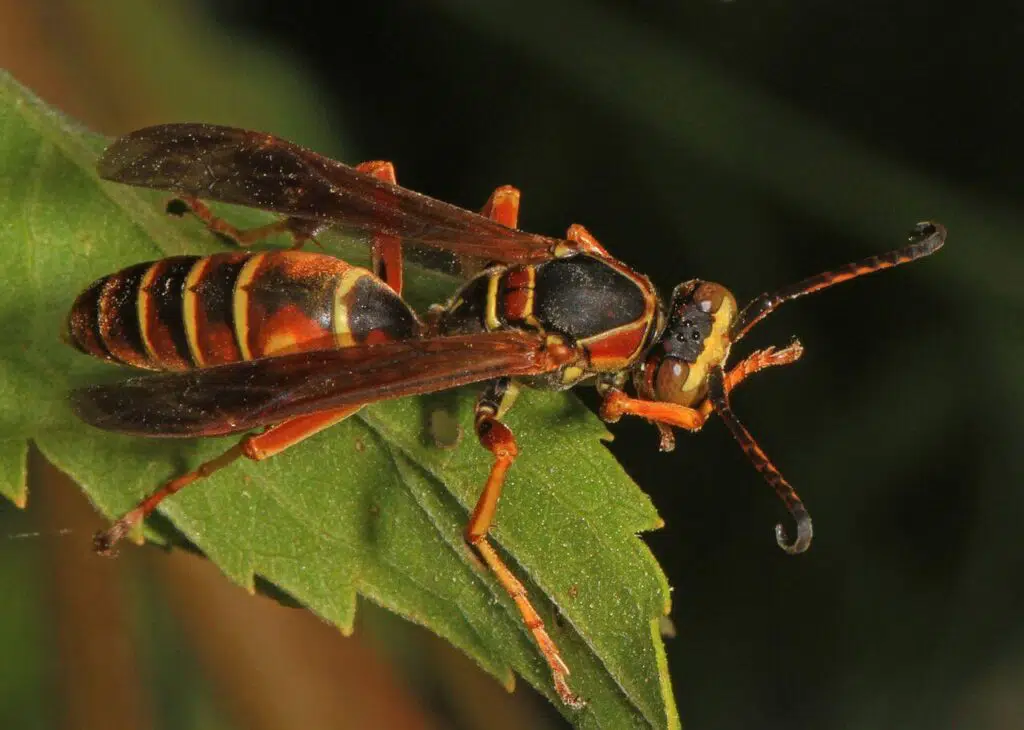
The dark paper wasp (Polistes fuscatus), also known as the northern paper wasp, are known to build their nests close to humans. They build nests in sheds, homes, barns, firewood, and fences. They use the wood to create the next, chewing the wood with saliva to make a paste.
They are very protective over their nest and being social, they live in large nests with hundreds of others of the same species. Accidentally disturbing a nest can cause multiple stings from a single wasp. They have a smooth stinger that can be removed without staying embedded.
5. Blue-winged Scoliid Wasp
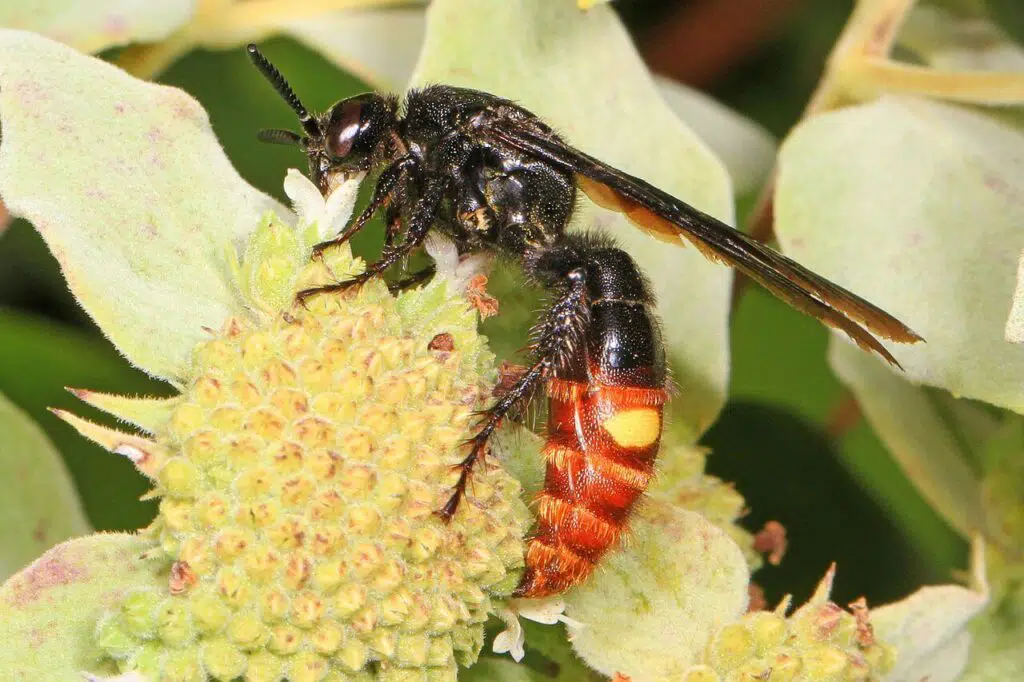
Blue-winged scoliid wasps (Scolia dubia) are also known as the two-spotted scoliid wasp. They grow to 2.5cm with a blackhead, thorax, and first two abdominal segments. The rest of the abdomen is red with yellow spots on the third segment.
Their wings are not obviously blue, but at certain angles, you can see they are blue/black. They are non-aggressive, but the female can sting and will continue to sting if she feels threatened. This wasp is useful in the garden, helping to eradicate Japanese beetles, which chew through leaves and petals.
The blue-winged scoliid wasps feed beetle grubs to their larvae. Females dig up and sting the beetle, then place it near the fertilized egg. They are mostly active in summer and can be seen visiting flowers and sipping on the nectar.
6. Guinea Paper Wasp
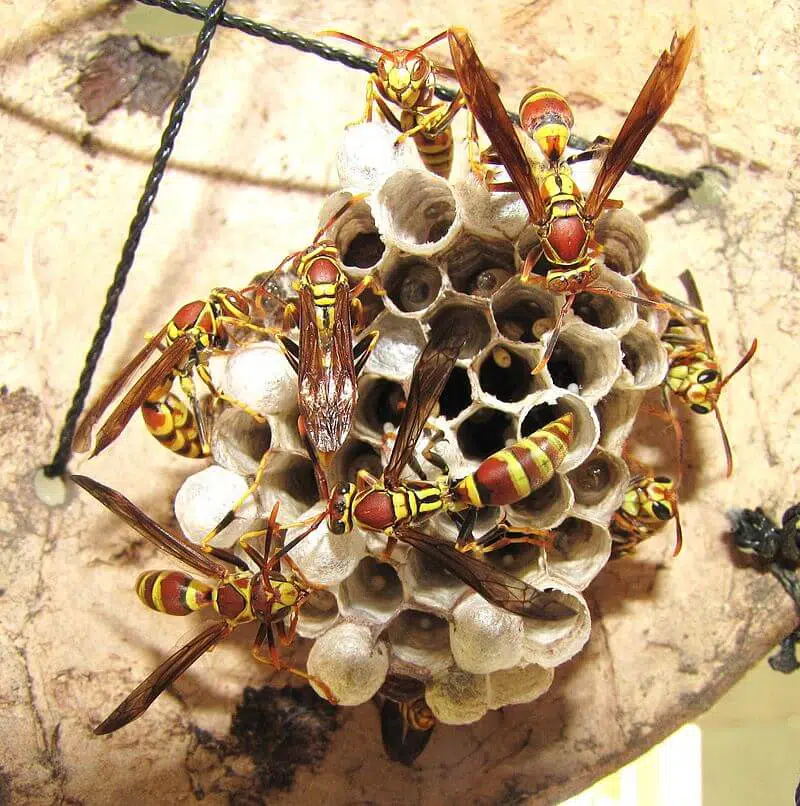
The Guinea paper wasp (Polistes exclamans) is a social wasp, belonging to the Vespidae family. There are two forms of this wasp with the typical form being found in North Carolina. Their colors vary, though they always have yellow coloration.
They usually have yellow on the propodeum and mesonotum, the propodeum has four yellow stripes and the mesonotum has yellow lines. They sometimes have yellow on their heads.
7. Gold-marked Thread-waisted Wasp
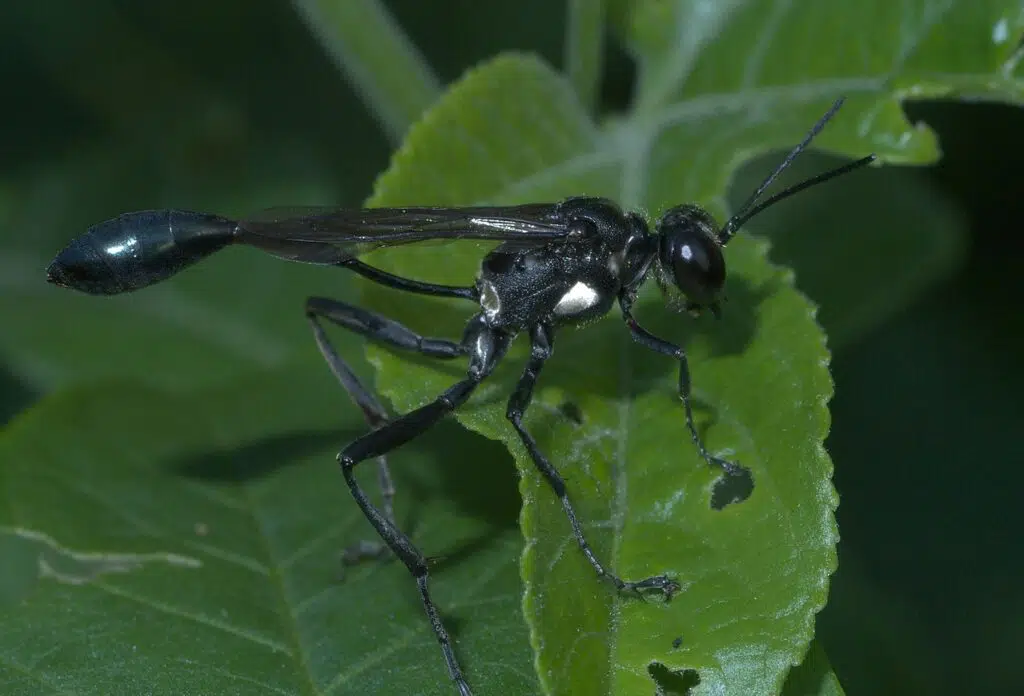
The gold-marked threat-waisted wasp (Eremnophila aureonotata) has a blue-black body with gold patches that are distinctive to this species. Females are known to dig burrows and provision them with lepidopteran larvae, including various moths.
They are commonly seen on wildflowers, especially Queens Anne’s Lace. They are sometimes seen feeding in pairs during mating season.
8. Wool Sower Gall Wasp
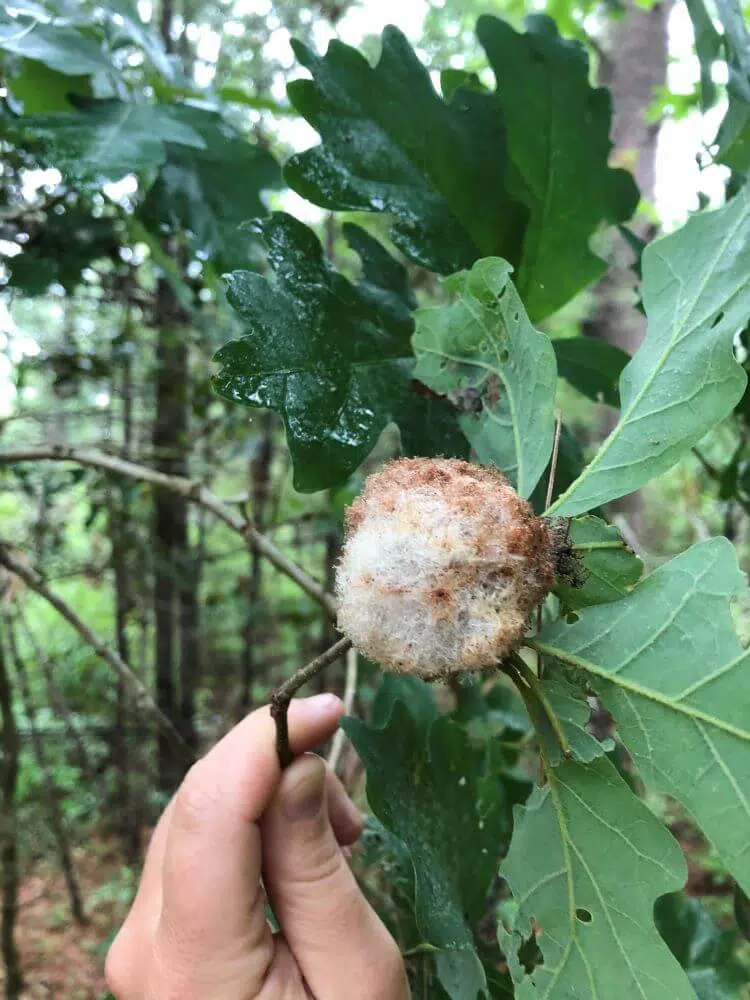
Galls are very distinctive and the gall from the wool sower gall wasp is round and wool with brown and pink spots. When you pull a gall apart, you see a seed-like structure, which contains the developing wasp. These wasps make their galls on oak trees, especially white oaks during the spring.
9. Eastern Cicada-killer Wasp
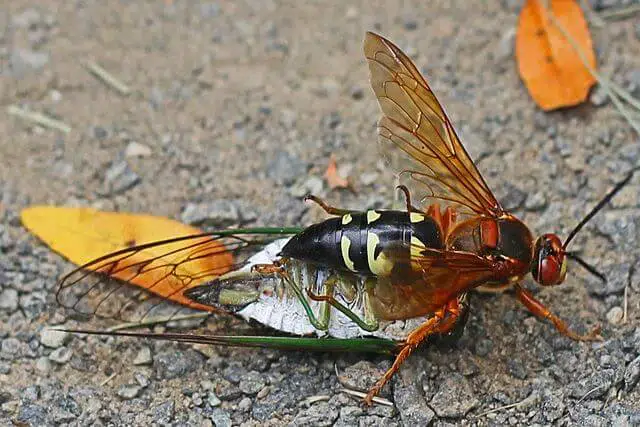
The Eastern cicada killer wasp (Sphecius speciosus) is a solitary digger wasp, also referred to as a sand hornet. They grow to 5cm in body length. They are robust, red, and hairy with black on their middle parts and a brown to red abdomen, which is marked in yellow stripes.
The females are larger than the males and remain one of the largest wasps you will encounter in North Carolina. They are not aggressive and seldom sting, even with their fearsome size. They are only known to sting when caught in clothing or stepped on.
Males are very aggressive towards other males, protecting their nesting sites. Males cannot sting but will put a sharp spine, which is found at the tip of the abdomen, into the skin. Both can bite but tend to fly away if you swat at them.
10. Bald-faced Hornet
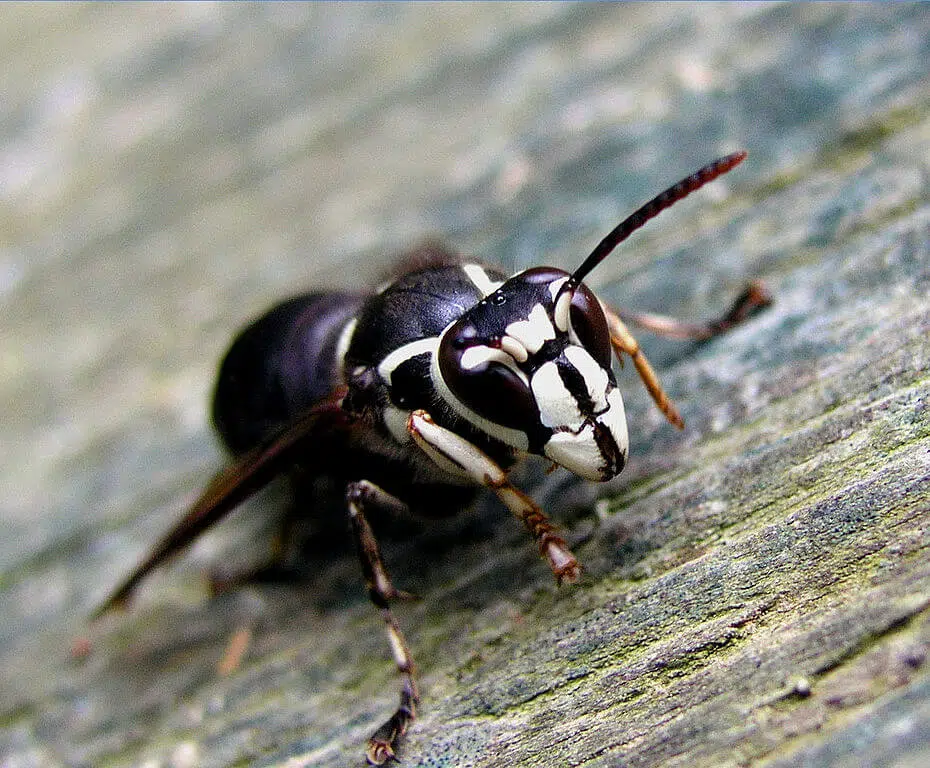
The bald-faced hornet (Dolichovespula maculata) is a member of the Vespidae family. They are a yellowjacket wasp species with large colonies of up to seven hundred workers. Their paper nests can be up to 58cm in length, which the workers defend aggressively.
Unlike other yellowjackets, the bald-faced hornet is black and white in color with three white stripes at the end of the body. They grow to 19mm in length with the queen being larger than the workers.
These are beneficial wasps that prey on caterpillars, flies, and spiders. They are aggressive and will defend their nest if you accidentally get too close. They are problems when they build their nets too close to a human home.
11. Four-toothed Mason Wasp
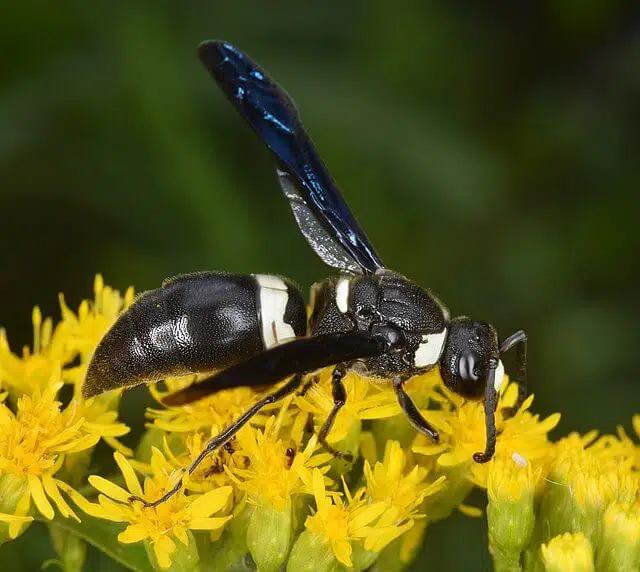
The four toothed mason wasp (Monobia quadridens) is a solitary potter wasp that has an 18mm wingspan, feeding on pollen and small caterpillars. They have a black abdomen with an ivory band. They can give a very painful sting.
Only females can sting, males can give a needle prick jab, though they do not have venom. The male uses the tip of his abdomen to push into your skin.
12. Southern Yellowjacket
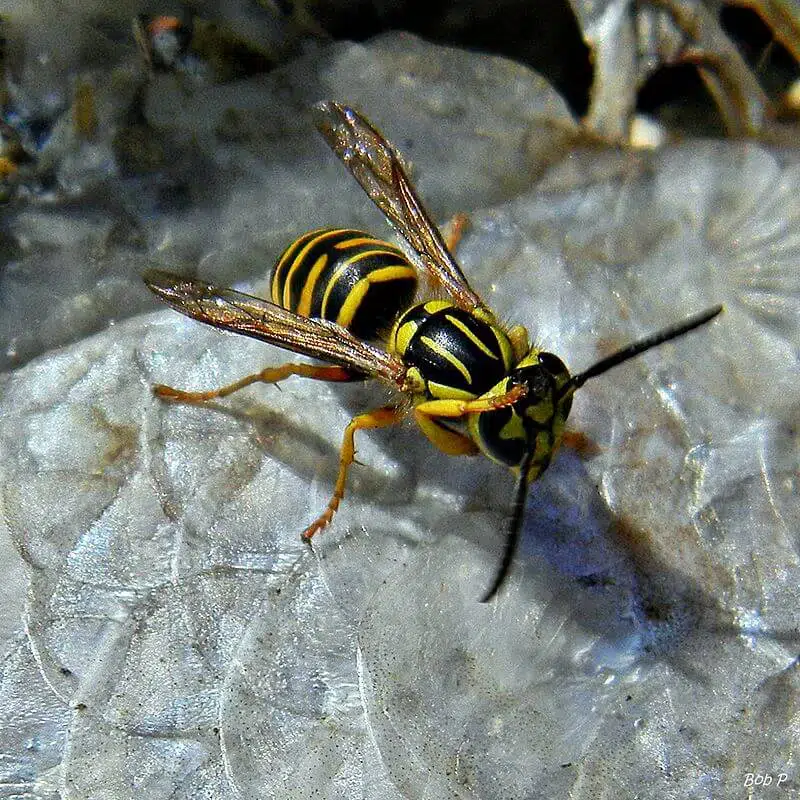
Southern yellowjackets (Vespula squamosa) are social wasps, known for their black and white patterns and an orange queen. They create large nests, feeding on insects. They are considered pests.
They grow to 1.3cm in body length and have yellow and black striping over their entire body with clear wings. The queen is larger than the males and workers and has more orange to her coloration.
They are found in locations with warm weather, where their nests can be seen in parks, yards, and on the roadside.
They are very common in urban areas and due to their close proximity to humans, along with the size of their nests, they are considered pests.
They give painful, venomous stings, which cause pain. If you accidentally disturb a net, you could face multiple stings as the entire colony will defend the nest.
13. Double-banded Scoliid Wasp
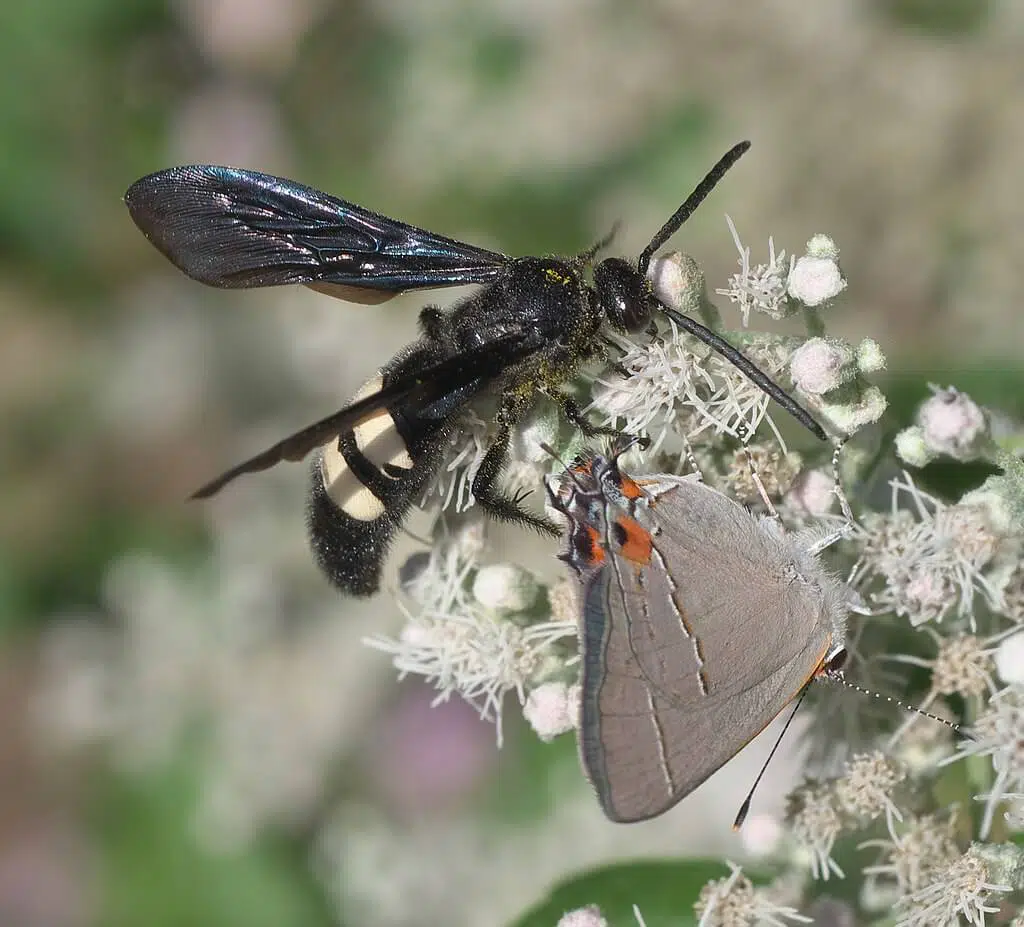
The double-banded scoliid wasp (Scolia bicincta) grows to 25mm in body length and is a dark and hairy wasp of medium size. They have two cream/white bands on the abdomen and are often found in fields with flowers.
This wasp is more common in late summer, from July, and can be seen until October in North Carolina. They are parasitoids of beetle larvae, using them to feed their own larvae.
14. Great Black Digger Wasp
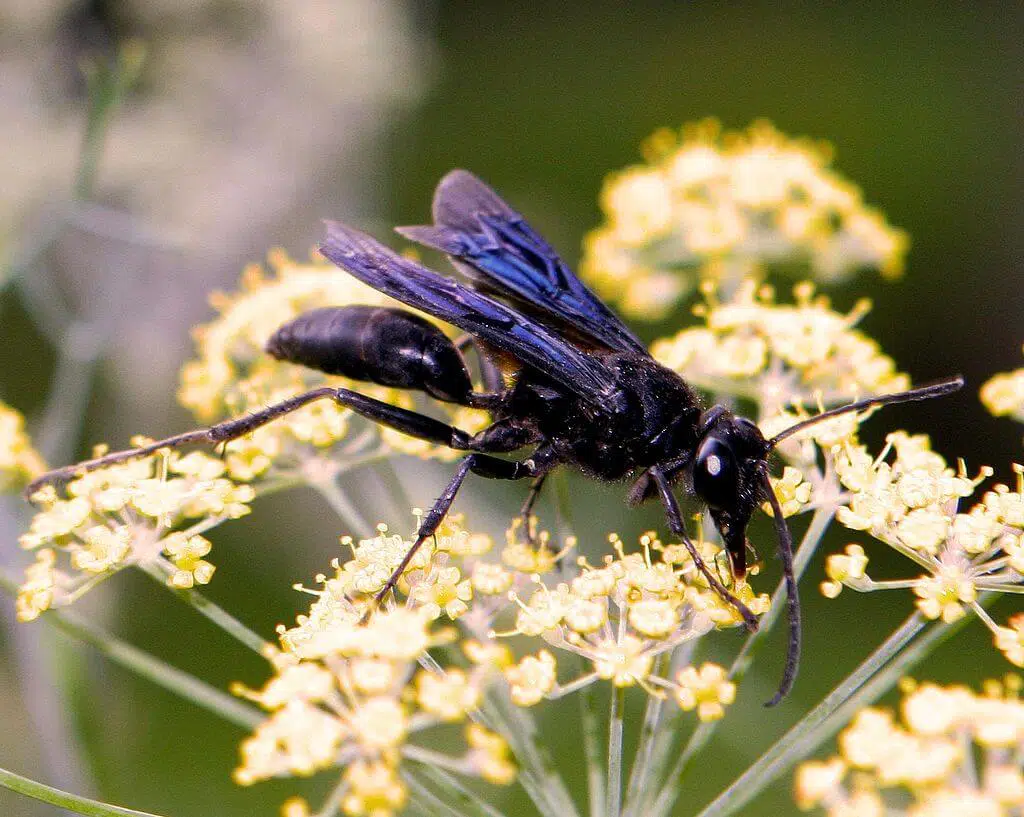
The great black digger wasp (Sphex pensylvanicus) can grow to 35mm in body length with its larvae feeding on living insects that the female paralyzes and carries to her underground nest. The male is smaller than the female, growing to 28mm in body length.
They have a painful sting. Their wings are smoky colored with a black body.
15. Noble Scoliid Wasp
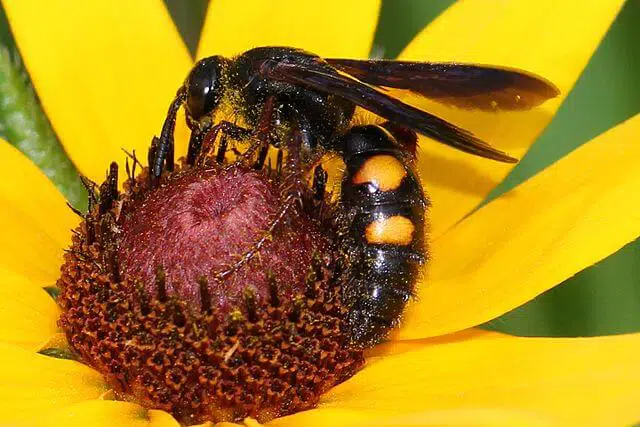
The noble scoliid wasp (Scolia nobilitata) can grow to 15mm in body length. These small wasps have dark wings and red coloration on their legs. Their dark abdomen has up to six yellow to orange spots.
This wasp prefers sandy meadows and is most common from June to September in North Carolina. Adults sip on nectar, while they feed their larvae grubs, usually that of the scarab beetle.
16. Great Golden Digger Wasp
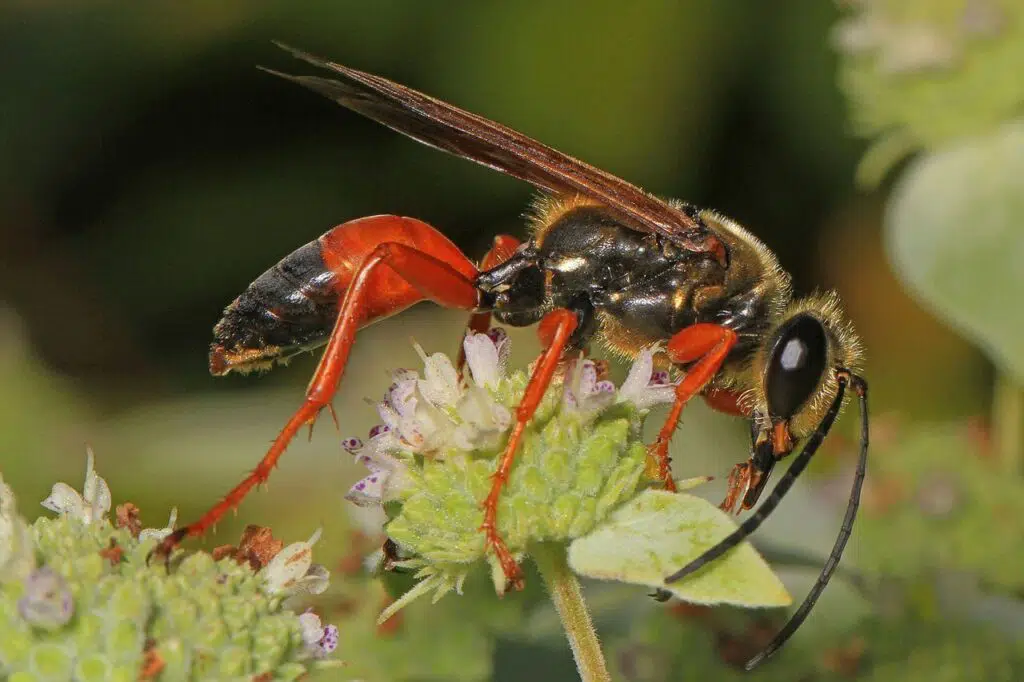
The great golden digest wasp (Sphex ichneumoneus) is a gentle wasp with vivid coloration. They mind their own business and are often seen sipping on nectar in the summer. Females build nests, which are deep tunnels, which they dig in loose soil.
The female catches small insects and places them in the tunnels. She is often chased by birds, who try and steal her prey.
The female does not, however, keep track of how many insects she catches based on the number of tunnels she has created. Sometimes meals are stolen, they do not realize they are short.
17. Fraternal Potter Wasp
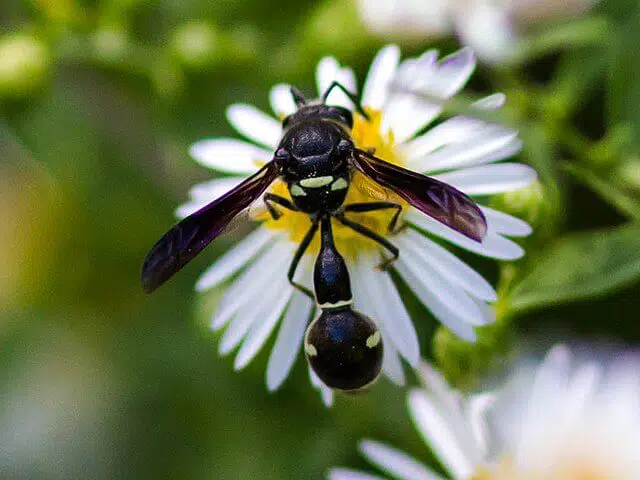
The fraternal potter wasp (Eumenes fraternus) makes a nest that looks like a small ceramic pot. These nests are built on branches and twigs. Each pot has one chamber.
Females lay one egg inside the chamber, add a paralyzed caterpillar and then seal the pot. The larva eats the caterpillar as it grows, eventually digging its way out of the chamber.
The fraternal potter wasp is not an aggressive species and is encountered more in the summer months.
18. Feather-legged Scoliid Wasp
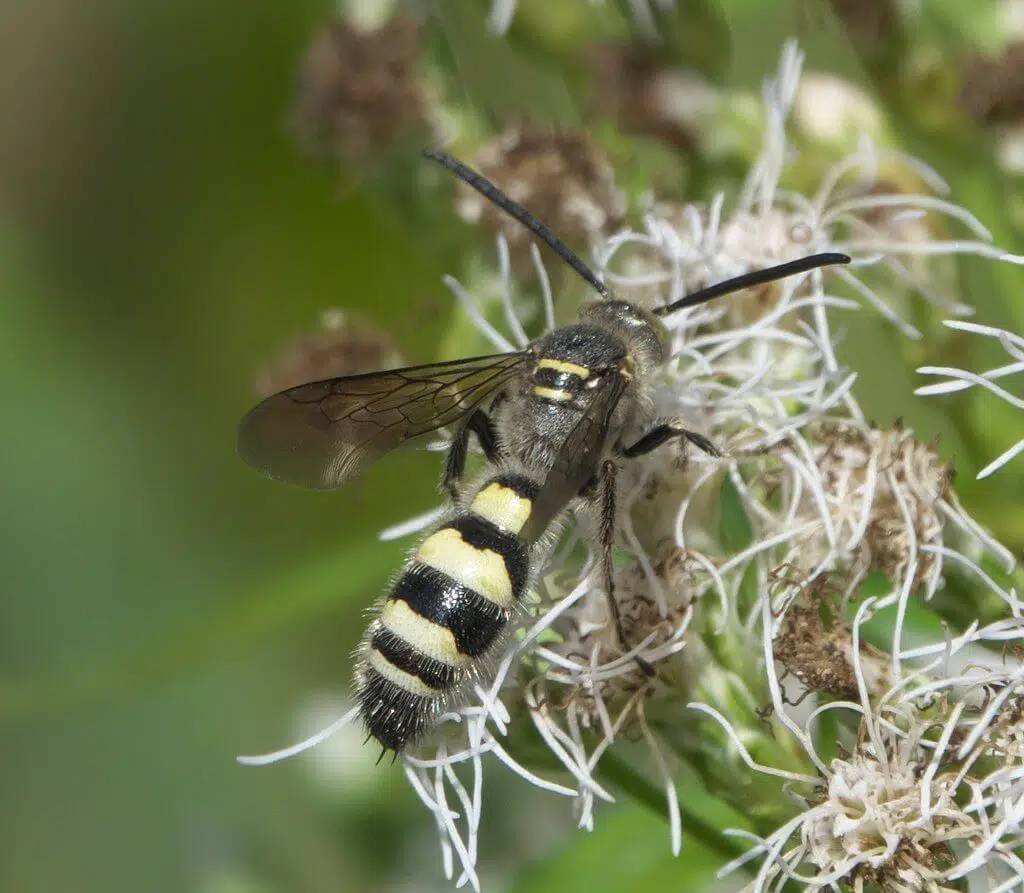
Feather legged scoliid wasps (Dielis plumipes) are medium-sized wasps, growing to 25mm in body length. They are hairy with yellow or cream/white spots and bands on their abdomens. This wasp is a parasite of the scarab beetle, using the scarab grub to feed the wasps larvae.
These non-aggressive species feed on the nectar of flowers and tend to leave you alone unless provoked.
19. Organ-pipe Mud-dauber Wasp
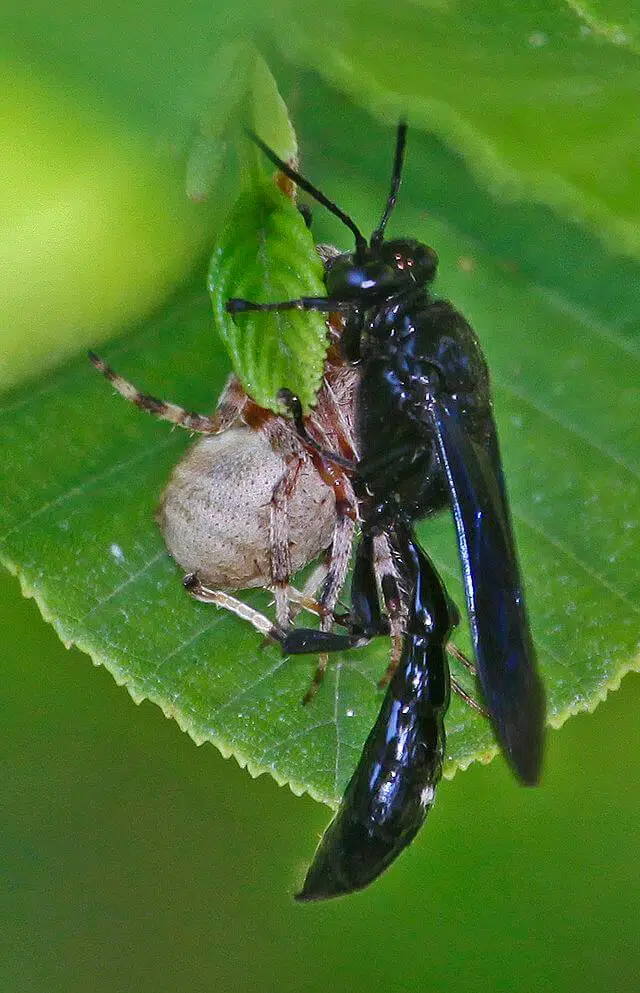
The organ-pipe mud dauber wasp (Trypoxylon politum) is a large predatory wasp, growing to 5.1cm in length. They fly from May to September and can be identified for their shiny black body with pale yellow to white hind legs.
These wasps feed mostly on spiders, Chrysidid wasps, and flies. This is a docile species, helping to keep spider populations at bay. They only sting in self-defense.
They choose their nest site based on smooth vertical surface, shade, protection from weather and mud. The nest is usually not far from a forest. Females form long mud tubes of multiple cells, which they fill with paralyzed spiders, which is food for the wasp larvae.
20. Nearctic Blue Mud-dauber Wasp
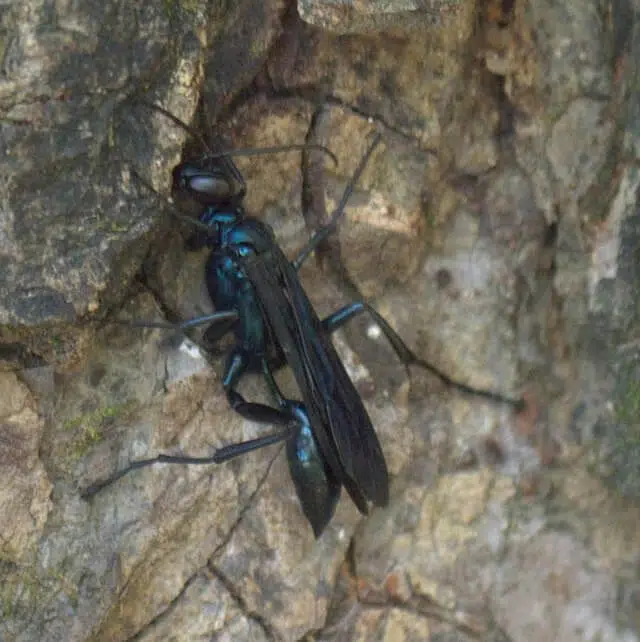
The Nearctic blue mud dauber wasp (Chalybion californicum) is also known as the common blue mud dauber and is metallic blue, first described in 1867. They are not aggressive towards humans and only the females can sting.
Females build nests, sometimes refurbishing abandoned wasp and bee nests. They line the nest with newly caught spiders to feed their larvae. This species is known to prey on black widow spiders to feed their larvae, while adults feed on nectar.
The nectar is believed to power their flight. They also help with the pollination of common wildflowers. Females hunt on the ground and under rocks looking for spiders for their nests.
21. Yellow-legged Mud-dauber Wasp
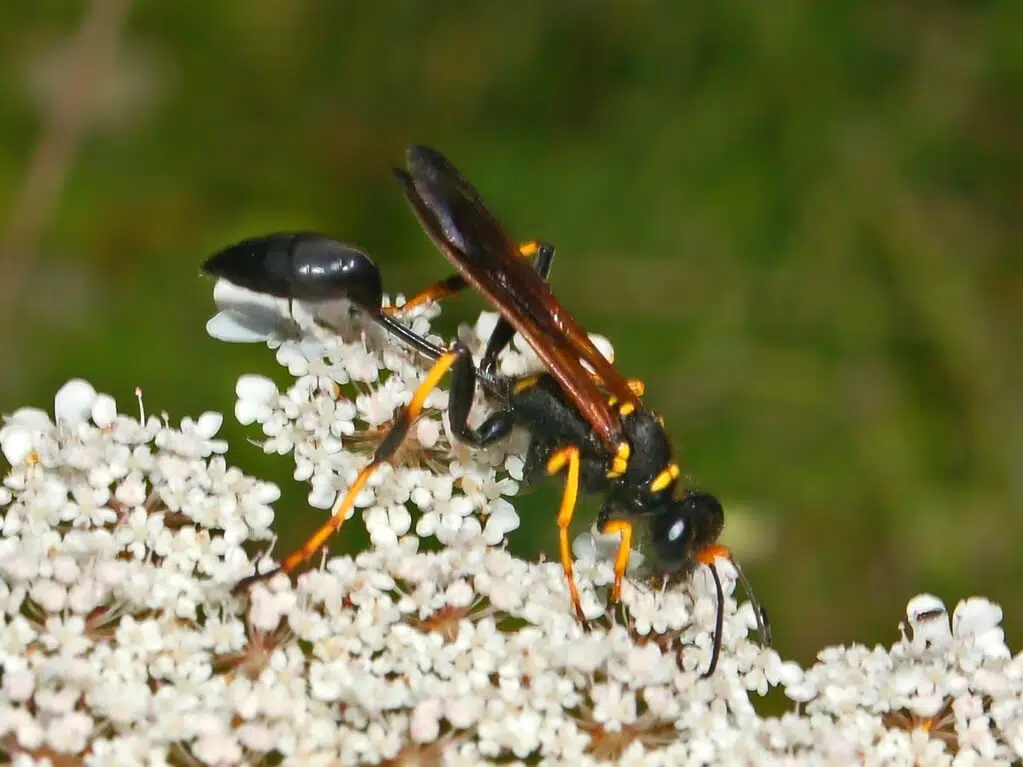
The yellow-legged mud dauber wasp (Sceliphron caementarium) is also known as the black and yellow mud dauber here in North Carolina. They can be found in a variety of habitats from homes and outbuildings to rock ledges, water edges, longleaf pines, turkey oaks, and cypress domes.
These wasps can grow to 1.10 inches (28mm) in body length with a black petiole, which is about half the length of the abdomen. Some have a yellow petiole, depending on their location. The thorax has yellow markings, while the abdomen remains black.
They are the only wasp species in the United States with yellow marked legs. Their wings are tawny.
A Boeing 757 crash in 1996 near Puerto Rico is believed to be a blockage in the Pitot tube, which was a result of a yellow-legged mud dauber nest.
22. Spongy Oak Apple Gall Wasp
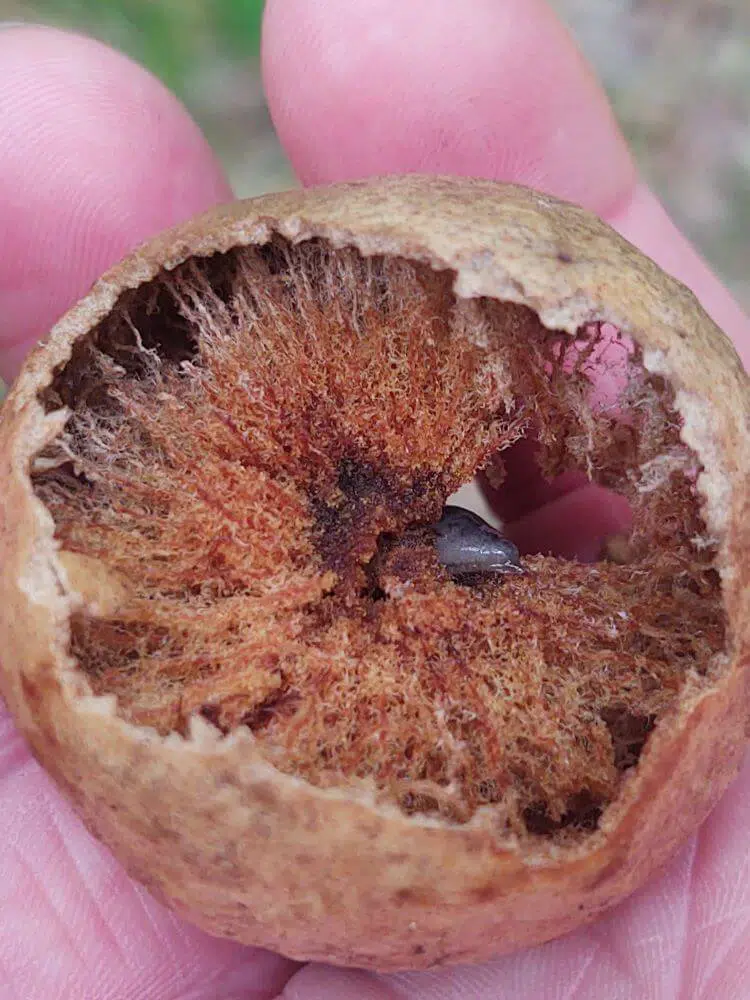
The adult spongy oak apple gall wasp (Amphibolips confluenta) is a dark wasp with a compressed oval-shaped abdomen. They are most common in red, scarlet, and black oaks, where the galls are initiated during spring and are known to take over the entire leaf.
The galls are green and become tan and thin on the outside as they mature.
The oak apple gall is a large, round, and apple-shaped gall found on a number of oak species. The apples range to 5cm in diameter and are a result of the chemicals injected by the larva.
Females lay an egg on the center of a budding oak leaf. As the egg hatches, the larva’s saliva causes the leaf to form a ball around the larva, protecting it. The larva eats from the leaf, hatching in mid-summer.
An adult wasp then hatches in June or July from the gall.
The males and females mate and drop to the ground, the female immediately burrows in the soil, injecting eggs into the roots. The larvae hatch and eat the roots over a year, the wingless female wasp hatch and crawl up the tree trunk in early spring, injecting eggs into the center vein of the leaf.
There is only one larva inside each gall.
Adults have wings, are small and dark. As soon as they climb out the gall, they find a mate and breed. Apple galls attract parasites, which sometimes injure or kill the wasp larva.
23. Four-banded Stink Bug Wasp
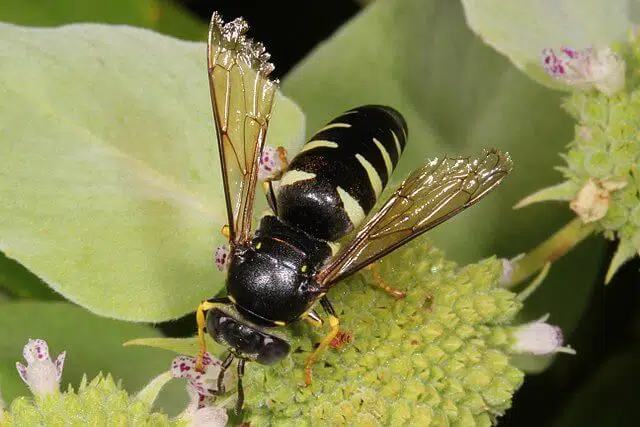
The four-banded stink bug wasp (Bicyrtes quadrifasciatus) can grow to 19mm in body length. In North Carolina, these wasps are more common between June and October where adults are seen foraging on flowers.
This wasp has four conspicuous cream abdominal stripes and was first discovered in 1823.
Females prey exclusively on nymphs of the true bug, mainly stink bugs. The female paralyzes the bug with her stinger, clasping it with her legs and mouthparts, as she flies it to her nest, which she has built underground.
She lays an egg on the nymph, which the wasp larvae feed off. Adults feed on flower nectar.
24. Hornworm Parasitoid Wasp

The hornworm parasitoid wasp (Cotesia congregata) belongs to the Cotesia genus, which is known for being parasites that kill the host. They are common parasitoids of the hornworm caterpillar and are commonly seen in yards. The adult female injects her eggs into the caterpillar.
Once the wasp eggs hatch, they feed on the tissues of the hornworm for a couple of weeks. There are a number of larvae per caterpillar. They then chew small holes in their holes and push their way through.
The larvae then spin silk cocoons and pupate outside their living host, still attached. The caterpillar then becomes a nursery for these wasps with adult wasps emerging after a couple of days, at which time the host caterpillar dies.
The hornworm parasitoid wasp has long and thin antennae, dark wings, and thin legs. They are natural control agents for hornworm, tobacco, and tomato hornworms,
25. Common Thread-waisted Wasp
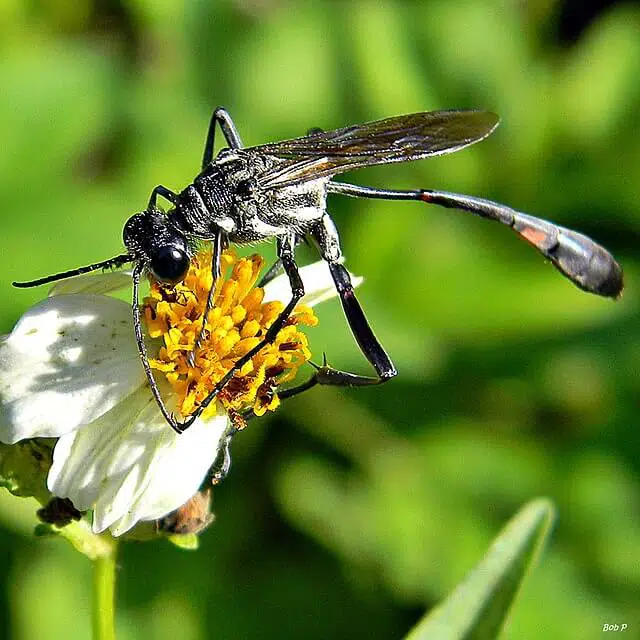
The common thread-waisted wasp (Ammophila procera) is an active hunter that paralyzes caterpillars and insects to feed their larvae.
These wasps have narrow waists and are glossy black with a bulging abdomen. There is orange or red near the thin waist.
The common threat-waisted wasp has long legs, which are black and skinny, helping them hold onto vegetation while they hunt for prey.
These are ambush predators, that immobilize their prey by injecting them with venom. They carry and drag the victim to their underground nest using their mouth and legs.
The wasp lays a tingle egg on the alive and motionless prey, which feeds the larva once it hatches. The adults drink nectar from flowers, along with feeding on small insects.
They are not aggressive to humans but will sting if handled or accidentally stepped on.
26. Ringed Paper Wasp
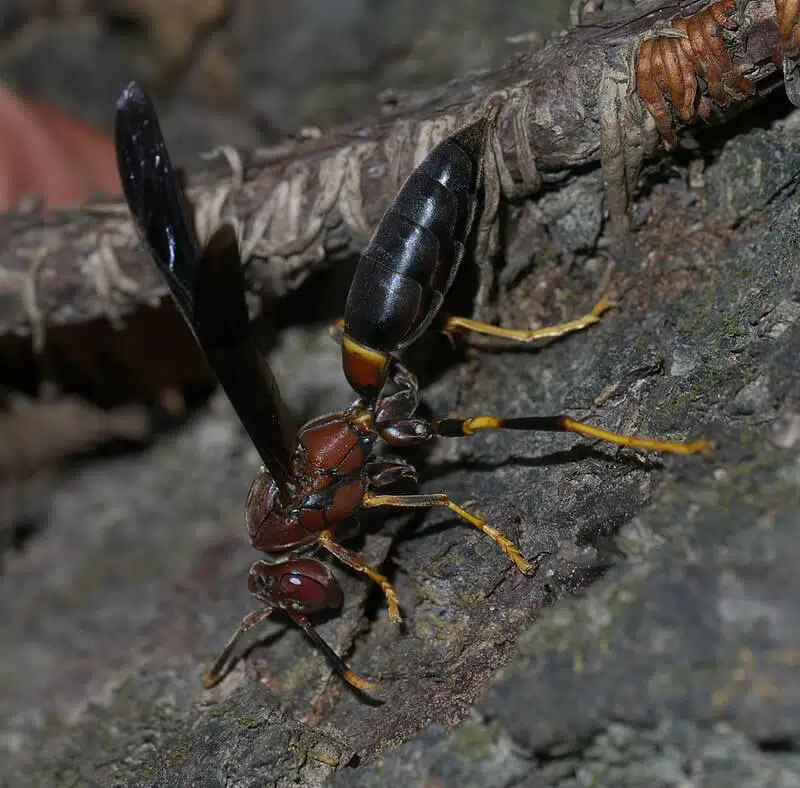
Ringed paper wasps (Polistes annularis) are known for their large size and black and red coloration.
They build nests under overhangs, close to water where there is minimal sunlight. Their nests are often clustered together, where the adults feed on flower nectar and small insects, such as ants.
They can manage the winter, often seen storing honey for hibernation. They have bright orange antennae segments, rusty-red head and thorax, and an almost black abdomen. There is a yellow ring at the end of the first segment.
In North Carolina, it’s hard to distinguish the ringed paper wasp with the P Bahamensis species, but the yellow markings on the mesopleuron are lacking in the ringed paper wasp. They also have less developed yellow on the mesosoma and no yellow banding on the tergum.
Males and females have red faces. Females have twelve antennae segments and six abdominal segments. Males, on the other hand, have thirteen antennae segments and seven abdominal segments.
27. Katydid Wasp

The Katydid wasp (Sphex nudus) is threat-waisted, belonging to the Sphecidae family.
They grow to 25mm in body length and are dark with a silver yellow on the thorax with tan-colored legs.
These wasps are more common from July to August in North Carolina, where they are seen visiting flowers and sipping on the nectar.
Females provision their nests with the preferred Carolina leaf roller cricket, which the larvae feed on until they mature.
Further Reading: